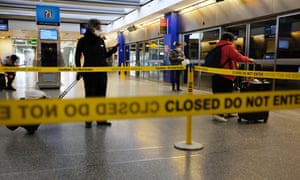Despite the restraint, the plan neglects to mention a firm target date or give an explicit strategy for national testing

Photograph: Spencer Platt/Getty Images
“Make America great again” was an election winning slogan with a bold and simple message. “Opening up America again” proved to be less clear cut and left questions in the air.
On Thursday Donald Trump unveiled federal staggered guidelines for getting America back to business after the shutdown forced by the coronavirus pandemic. He had previously billed it as the most important decision of his presidency, but what he called “a science-based reopening” was messier and more ill-defined.
First, the good news. The 18-page document explicitly used the word “guidelines” – a far cry from the “total authority” he claimed earlier this week. It delegates authority to state governors and city mayors to weigh the risk-to-reward ratio of opening businesses, churches and schools, which is the way it should be.
It also recognises the need to move gradually with baby steps, and the fact that America is vast – roughly the same size as Europe – with different needs in different places. “We are not opening all at once, but one careful step at a time, and some states, they will be able to open up sooner than others,” the president said,
Even Trump, who has turned his briefings into mini-campaign rallies, seemed relatively disciplined and focused at the White House on Thursday. He was broadly in step with his experts, Dr Deborah Birx and Dr Anthony Fauci. For all his wild words in recent weeks, including calling for the country to reopen at Easter, Trump has at least heeded the professionals when it came to extending physical distancing guidelines and now seeking to wind them down.
The document proposes that, before reopening, states should see a decrease in confirmed Covid-19 cases over a 14-day period, have a “robust testing system in place for at-risk health care workers”, and hospitals should be able to “treat all patients without crisis care”.
But there are plenty of ambiguities. The guidelines do not give a firm target date. Trump said some states could reopen “tomorrow” but declined to name them. The guidelines emphasise the need for testing but do not make clear how many tests will be enough, nor set out a national testing strategy. Yet testing and contact tracing have been key to the relative success of countries such as Germany and South Korea.
House speaker Nancy Pelosi criticized the guideline’s lack of clarity on a national testing strategy, saying in statement: “Testing is the key to opening our country to resume our lives. The White House’s vague and inconsistent document does nothing to make up for the president’s failure to listen to the scientists and produce and distribute national rapid testing.”
In the absence of that secure knowledge, the public may not respond to Trump’s summons. More than four in five people say Americans should “continue to social distance for as long as is needed to curb the spread of coronavirus, even if it means continued damage to the economy”, according to a Politico/Morning Consult poll released Wednesday.
And even on one of his more restrained days, Trump made some worrying statements. He kept referring to the virus in the past tense, even as thousands of people continue to die every day. “Now that we are past the peak in new cases, we are starting life again,” he said.
“If the virus returns in the fall as some scientists think it may, possibly, these guidelines will ensure the country is up and running so that we can likewise put it out quickly.”
Joe Lockhart, a former White House press secretary, tweeted: “That briefing had everything but the ‘Mission Accomplished’ banner. Now let’s start ignoring the president and concentrate on where the power is: the states and cities.”
In the week that he halted funding to the World Health Organization, Trump made reference to “a cruel virus from a distant land” and said border control and travel restrictions are more important than ever. He reflected: “In 1917, they went through something that was similar”, – he was off by a year, as the Spanish flu was in 1918.
And he told reporters: “We’re not going to have a new normal. Normal is going to be if a restaurant had 158 seats filled before, they are going to have 158 seats filled again.” Experts have warned such a prospect is still a very long way off.
The political benefit of asking individual states to call the shots is that, if things go wrong, Trump will claim he is shielded from blame. He said: “We have some states that got too much credit for what they’ve done, frankly. I could name you a couple of those.”
Trump described himself as a healer and claimed that partisan politics should be put aside. “I don’t care about campaigning,” he said. But it will not be long, perhaps, before he is back on the trail.



